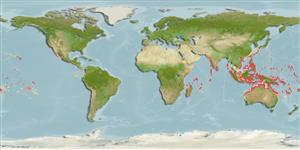>
Gobiiformes (Gobies) >
Gobiidae (Gobies) > Gobiinae
Etymology: Pleurosicya: Greek, pleura = side, ribe + Greek, sikya, -as = cucumber (Ref. 45335).
More on author: Larson.
Environment: milieu / climate zone / profondeur / distribution range
Écologie
marin récifal; profondeur 10 - 32 m (Ref. 37816). Tropical
Indo-West Pacific: Chagos Archipelago to Papua New Guinea, north to the Philippines, south to northwestern Australia. Recently recorded from Tonga (Ref. 53797).
Taille / Poids / Âge
Maturité: Lm ? range ? - ? cm
Max length : 3.5 cm SL mâle / non sexé; (Ref. 48637)
Description synthétique
Clés d'identification | Morphologie | Morphométrie
Épines dorsales (Total) : 6 - 7; Rayons mous dorsaux (Total) : 7 - 8; Épines anales: 1; Rayons mous anaux: 7 - 9. Characterized by semi-transparent, with pale pink or reddish orange hue; covered with pepper-like pigmentation; snout with brown to reddish stripe on side; longitudinal scale series 22-26; head, nape, belly midline and breast without scales; opening of gill reaching to at least below edge of preopercle; depth of body at anus 5.3-7.1 in SL (Ref. 90102).
Body shape (shape guide): elongated; Cross section: compressed.
Inhabits solid sponges at moderate depths, usually in 10 meters or more, but probably depending on the occurrence of certain sponges (Ref. 48637). Collected from reef flats and lagoon and reef channels (Ref. 37816).
Life cycle and mating behavior
Maturité | Reproduction | Frai | Œufs | Fécondité | Larves
Kailola, P.J., 1991. The fishes of Papua New Guinea: a revised and annotated checklist. Vol. III. Gobiidae to Molidae. Research Bulletin No. 41, Research Section, Dept. of Fisheries and Marine Resources, Papua New Guinea. 153 p. (Ref. 6771)
Statut dans la liste rouge de l'IUCN (Ref. 130435: Version 2025-1)
Menace pour l'homme
Harmless
Utilisations par l'homme
Pêcheries: pêcheries vivrières
Outils
Articles particuliers
Télécharger en XML
Sources Internet
Estimates based on models
Preferred temperature (Réf.
123201): 24.7 - 28.8, mean 27.6 °C (based on 326 cells).
Phylogenetic diversity index (Réf.
82804): PD
50 = 0.5000 [Uniqueness, from 0.5 = low to 2.0 = high].
Bayesian length-weight: a=0.00724 (0.00339 - 0.01546), b=3.10 (2.92 - 3.28), in cm total length, based on LWR estimates for this (Sub)family-body shape (Ref.
93245).
Niveau trophique (Réf.
69278): 3.2 ±0.3 se; based on size and trophs of closest relatives
Résilience (Réf.
120179): Haut, temps minimum de doublement de population inférieur à 15 mois (Preliminary K or Fecundity.).
Fishing Vulnerability (Ref.
59153): Low vulnerability (10 of 100).
🛈
Nutrients (Ref.
124155): Calcium = 305 [127, 724] mg/100g; Iron = 1.22 [0.56, 2.56] mg/100g; Protein = 17.7 [15.6, 19.5] %; Omega3 = 0.108 [0.041, 0.247] g/100g; Selenium = 28.4 [10.3, 74.9] μg/100g; VitaminA = 139 [33, 566] μg/100g; Zinc = 3.29 [1.96, 5.20] mg/100g (wet weight);
